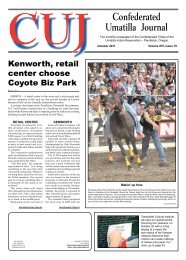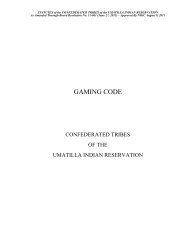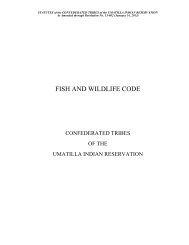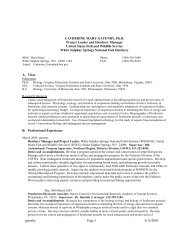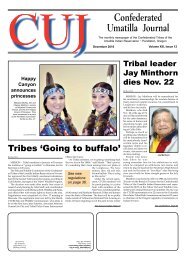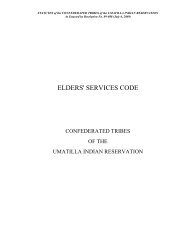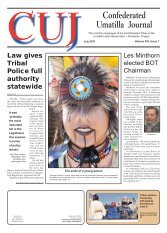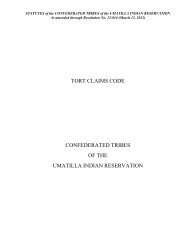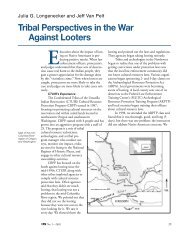November 2011 CUJ - Confederated Tribes of the Umatilla Indian ...
November 2011 CUJ - Confederated Tribes of the Umatilla Indian ...
November 2011 CUJ - Confederated Tribes of the Umatilla Indian ...
- No tags were found...
Create successful ePaper yourself
Turn your PDF publications into a flip-book with our unique Google optimized e-Paper software.
<strong>Indian</strong> tribe uses tradition to combat suicidesBy TOM MAST, Casper Star-TribuneCASPER, Wyo. (AP)It began inside a jail cell, where ayoung man hanged himself.What followed was a cascade <strong>of</strong> deaththat threatened to engulf <strong>the</strong> Wind River<strong>Indian</strong> Reservation.During August and September <strong>of</strong> 1985,nine young people killed <strong>the</strong>mselves.Most were Nor<strong>the</strong>rn Arapahos.Four <strong>of</strong> <strong>the</strong> victims were between <strong>the</strong>ages <strong>of</strong> 14 and 19, and five between 23and 26.Three additional victims, between <strong>the</strong>ages <strong>of</strong> 18 and 23, had ties to <strong>the</strong> reservationand to some <strong>of</strong> <strong>the</strong> o<strong>the</strong>r victims.Eighty-eight verified suicide attemptsor threats also were recorded, <strong>the</strong> majorityby young people 13 to 19 years old.Mental health experts from around <strong>the</strong>nation tried to intervene.``But it wasn’t doing any good,’’ NelsonWhite Sr., an Arapaho elder, recalled.National media descended on <strong>the</strong>scene, an intrusion many people resentedas insensitive and bent on sensationalism.One television crew tried to crash a victim’sfuneral. Eventually, tribal leadersbarred <strong>the</strong> press from <strong>Indian</strong> land.Almost as quickly as it spread, <strong>the</strong>contagion ended.Alcohol was a direct contributing factorin four <strong>of</strong> <strong>the</strong> deaths. But in <strong>the</strong> absence<strong>of</strong> concrete answers, larger causesremained matters <strong>of</strong> conjecture.At <strong>the</strong> height <strong>of</strong> <strong>the</strong> episode, anArapaho elder remembered that certainceremonies had been performed duringan epidemic many years earlier.Prayers were said, and <strong>of</strong>ferings madeto <strong>the</strong> four directions and to <strong>the</strong> Creator,to purify and restore harmony in a mannerconsistent with traditional beliefs.Elders Nelson White Sr. and CrawfordWhite said that’s when <strong>the</strong> deathsstopped.Their account is corroborated by ascientific review <strong>of</strong> <strong>the</strong> incident.In a journal article, Margene Tower<strong>of</strong> <strong>the</strong> <strong>Indian</strong> Health Service referred toa ``traditional medicine’’ ceremony thathappened at <strong>the</strong> height <strong>of</strong> <strong>the</strong> epidemic.``This ceremony was held following<strong>the</strong> ninth suicide,’’ she wrote. ``It was animportant cultural and spiritual eventthat aided in <strong>the</strong> resolution <strong>of</strong> grief andincreased cohesiveness in <strong>the</strong> community.No fur<strong>the</strong>r deaths occurred afterthis ceremony was held.’’She noted that while suicide attemptsremained abnormally high for twomonths after <strong>the</strong> ninth deaths, <strong>the</strong>se soonsubsided as well.It was <strong>the</strong> power <strong>of</strong> community anda people’s prayer that broke <strong>the</strong> deadlycycle, Nelson White Sr. said: ``We belongto <strong>the</strong> Creator.’’What happened among <strong>the</strong> Nor<strong>the</strong>rnArapahos in 1985 has not been forgotten.Efforts to forestall suicides today incorporateceremonies conducted in <strong>the</strong>Arapaho language, talking circles, sweatlodges and involvement <strong>of</strong> elders, allwoven toge<strong>the</strong>r in a kind <strong>of</strong> communitysafety net.Trained suicide interveners watch forearly signs <strong>of</strong> trouble. Both <strong>the</strong> Nor<strong>the</strong>rnArapahos and <strong>the</strong> Eastern Shoshoneswith whom <strong>the</strong>y share <strong>the</strong> Wind Riverreservation have suicide preventionprograms. These efforts have been largelysuccessful.In 2009, an 18-year-old woman sho<strong>the</strong>rself to death in Arapahoe, according torecords <strong>of</strong> <strong>the</strong> Fremont County coroner.Before that, a young person had not diedby suicide since 2003, when a 10-year-oldFort Washakie boy killed himself.Between 2000 and 2010, 116 peoplein Fremont County killed <strong>the</strong>mselves.Twenty-seven, or 23 percent, wereAmerican <strong>Indian</strong>.Chaos erupted.A 15-year-old boy threatened to harmhimself with a knife; screaming and confusionensued.The cops wanted to jolt <strong>the</strong> boy witha Taser gun; nobody wanted him to run.Into this tumult stepped Telano Groesbeck,only a couple <strong>of</strong> weeks out <strong>of</strong> suicideprevention training.``I was scared,’’ he said. ``My heartwas pumping.’’ Would he say <strong>the</strong> wrongthing and make matters worse?Groesbeck began searching for somethread that would establish a connection.And among <strong>the</strong> Nor<strong>the</strong>rn Arapaho,<strong>the</strong>re’s always a connection.``The whole tribe’s a family,’’ CrawfordWhite said. ``One way or ano<strong>the</strong>r,we’re related.’’On this occasion, Groesbeck knew <strong>the</strong>teenager’s dad, which established somecommon ground. Slowly, a potentiallylethal situation was defused.The Nor<strong>the</strong>rn Arapaho tribe provideswithin its structure a support network forearly intervention.A distraught young person confidesin a friend, who alerts an aunt, who tellsGroesbeck, who invites <strong>the</strong> young personto a talking circle or a youth sweat lodge.Groesbeck said depression and suicidalthoughts <strong>of</strong>ten are intertwined withdrugs and alcohol abuse.In a sense, such behaviors are a slowmotion form <strong>of</strong> self-destruction: ``They’rekilling <strong>the</strong>mselves doing it,’’ he said.The roots <strong>of</strong> destructive behavior canbe complex, but Groesbeck said <strong>the</strong> perniciousimpact <strong>of</strong> bullying is sometimesmissed. A child bullied at school mightalso be bullied in reservation housing by<strong>the</strong> same tormentors, and so abuse can beunrelenting.``The answer’s always within <strong>the</strong> kid,’’he said. ``You have to listen.’’Suicide prevention efforts <strong>of</strong>ten arehigh-pr<strong>of</strong>ile. Harmony Spoonhunter, director<strong>of</strong> Eastern Shoshone Tribal Health,noted that a suicide prevention powwowwas held in June.Powwows are major communityevents. They can be used as an opportunityto share information and galvanizecommunity action.Suicide prevention programs inschools also are common, and both tribesactively seek to train people in suicideprevention.George Leonard, suicide preventioncoordinator for <strong>the</strong> Nor<strong>the</strong>rn Arapahos,likened <strong>the</strong> stirring <strong>of</strong> suicidal thoughtsto a wild river. The goal is to rescue ayoung person at risk before he or shereaches <strong>the</strong> falls.Talking circles and sweat lodges provideyoung people with opportunitiesto learn more about <strong>the</strong>ir language, <strong>the</strong>irculture and traditional spirituality, and<strong>the</strong>refore <strong>the</strong>mselves, he said.RE-ELECTChairman, Board <strong>of</strong> Trustees (current)<strong>November</strong>. 15, <strong>2011</strong>52 <strong>Confederated</strong> <strong>Umatilla</strong> Journal<strong>November</strong> <strong>2011</strong>





